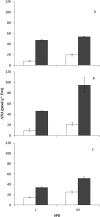Natural variation in stomatal response to closing stimuli among Arabidopsis thaliana accessions after exposure to low VPD as a tool to recognize the mechanism of disturbed stomatal functioning
- PMID: 25205580
- PMCID: PMC4246184
- DOI: 10.1093/jxb/eru370
Natural variation in stomatal response to closing stimuli among Arabidopsis thaliana accessions after exposure to low VPD as a tool to recognize the mechanism of disturbed stomatal functioning
Abstract
Stomatal responses to closing stimuli are disturbed after long-term exposure of plants to low vapour pressure deficit (VPD). The mechanism behind this disturbance is not fully understood. Genetic variation between naturally occurring ecotypes can be helpful to elucidate the mechanism controlling stomatal movements in different environments. We characterized the stomatal responses of 41 natural accessions of Arabidopsis thaliana to closing stimuli (ABA and desiccation) after they had been exposed for 4 days to moderate VPD (1.17 kPa) or low VPD (0.23 kPa). A fast screening system was used to test stomatal response to ABA using chlorophyll fluorescence imaging under low O2 concentrations of leaf discs floating on ABA solutions. In all accessions stomatal conductance (gs) was increased after prior exposure to low VPD. After exposure to low VPD, stomata of 39 out of 41 of the accessions showed a diminished ABA closing response; only stomata of low VPD-exposed Map-42 and C24 were as responsive to ABA as moderate VPD-exposed plants. In response to desiccation, most of the accessions showed a normal stomata closing response following low VPD exposure. Only low VPD-exposed Cvi-0 and Rrs-7 showed significantly less stomatal closure compared with moderate VPD-exposed plants. Using principle component analysis (PCA), accessions could be categorized to very sensitive, moderately sensitive, and less sensitive to closing stimuli. In conclusion, we present evidence for different stomatal responses to closing stimuli after long-term exposure to low VPD across Arabidopsis accessions. The variation can be a useful tool for finding the mechanism of stomatal malfunctioning.
Keywords: Arabidopsis thaliana; abscisic acid; desiccation.; natural variation; stomata; vapour pressure deficit (VPD).
© The Author 2014. Published by Oxford University Press on behalf of the Society for Experimental Biology.
Figures











References
-
- Aliniaeifard S, Malcolm Matamoros P, van Meeteren U. 2014. Stomatal malfunctioning under low vapour pressure deficit (VPD) conditions: Induced by morphological and anatomical or by signalling alterations? Physiologia Plantarum . 10.1111/ppl.12216. - PubMed
-
- Appleby RF, Davies WJ. 1983. A possible evaporation site in the guard cell wall and the influence of leaf structure on the humidity response by stomata of woody plants. Oecologia 56, 30–40. - PubMed
-
- Arve LE, Terfa MT, Gislerød HR, Olsen JE, Torre S. 2012. High relative air humidity and continuous light reduce stomata functionality by affecting the ABA regulation in rose leaves. Plant, Cell and Environment 36, 382–392. - PubMed
Publication types
MeSH terms
Substances
LinkOut - more resources
Full Text Sources
Other Literature Sources
Molecular Biology Databases

